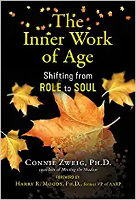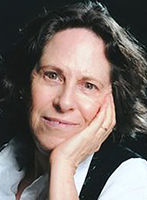For many people, retirement ushers in a new life stage, one following career and family-building and preceding the frailties that may come with older age. For many, it’s a time of reinvention without a blueprint, a shift to flextime, part-time, volunteering, service, lifelong learning, or caregiving.
Some large companies are catching on, becoming aware of the reservoir of talent, knowledge, communication skills, and resiliency of older workers. CVS Health’s Talent Is Ageless initiative builds public and private partnerships to recruit older workers. The Hartford, an insurance giant, even goes to senior centers to find older employees. And AT&T reports that they intend to keep older employees at work for as long as possible.
However, all this emphasis on working and doing has a shadow side: it stresses that purpose comes through productivity and doesn’t appear to include more service-oriented doing or more contemplative, spiritual development. Therefore, I was encouraged to find the results of a study by Anne Colby and William Damon at the Stanford Graduate School of Education, in collaboration with Encore.org: Large numbers of older people rank “purpose beyond the self” very high on their lists of priorities and are taking steps to realize it. In fact, this desire was expressed by a majority of respondents across differences in income, education, race, gender, and health status. (The study was reported by Katie Remington and Matt Bendick in the Stanford University Publication Cardinal at Work.)
In addition, for those surveyed, finding purpose doesn’t require the sacrifice of personal growth. When asked whether their views of late life are reflected in the statement “It’s a time for personal growth,” 67 percent responded that this descriptor is accurate.
This finding helps explain an ongoing trend among older workers, which can be seen as an expression of personal change from the outside in. Nearly half of older workers have changed jobs since turning fifty, altering a century-long cultural pattern in which people tended to work at the same job or profession until they retired. And many more want to, we have to assume, but are reluctant. Some may need “bridge income” on their way to their destination, to take courses or get certified, or to pay bills while they search for the right position or vision of how to take an idea into action. Others may need to uncover the inner obstacles in their shadows—fears of age discrimination, failure, health problems, technology, or loss of time for other activities.
Encore Entrepreneurs
Many older people today are taking the reins and launching their own start-ups. In New York, for example, the growing number of entrepreneurs over age fifty defies the stereotype of the young twenty-something in blue jeans. The number of those over fifty who became entrepreneurs in 2016 rose 63 percent from the number in 2000. In comparison, as reported by Winnie Hu in the New York Times, the total number of residents at that age rose only 28 percent over the same period of time.
According to Encore.org, an international community that creates intergenerational solutions to pressing problems, more than twelve million older people are “encore entrepreneurs” who want to put their experience to work for the greater good. Many plan small, local ventures to meet needs in their communities. Intel, the giant tech company, partnered with Encore.org to offer Encore Fellowships to its retirement-eligible employees. They receive a $25,000 stipend and placement with a high-performing nonprofit as a stepping-stone to redeploying their skills in a new career.
Research suggests that age may be an advantage for entrepreneurs: One study found that there were twice as many successful founders over fifty as under twenty-five, and twice as many over sixty as under twenty. Ray Kroc was in his fifties when he launched McDonald’s; Colonel Sanders was in his sixties when he started Kentucky Fried Chicken; Steve Jobs was as creative in his second stint at Apple as in his first. (For details, see the 2012 blog post “Enterprising Oldies,” for The Economist.)
Discovering a New Passion
Heather, a colleague, had several positions in education: high school English teacher, assistant principal, and principal. Then she moved to Alaska and worked for a college education program where she taught teachers. She also ran conferences to train caregivers for older people. Her role as an educator took many different forms until her mother became seriously ill and moved in with Heather and her husband. Then Heather became the caregiver and switched over to part-time work.
Heather found purpose as a caregiver, as a mother to her mother, as she put it. She identified more and more deeply with the role. “For me, every day is Mother’s Day,” she told me.
Then, at the age of 101, her mom died. And Heather’s purpose died as well. She took a family leave from her job and, while grieving, drove up and down the West Coast doing mobile coaching on her phone. Soon after that, she quit her job, aware that she was looking for the next stage.
“I took off all the hats that gave me power—principal, teacher, even caregiver. It’s been really humbling,” she told me. It seemed that she had released her identification with those roles and moved into a liminal, formless space.
After drifting for a while, she went to a ten-day meditation retreat and realized that she was in a late-life identity crisis. She was no longer a mom or an educator. She had no professional label and no defined role. She read books on aging, did volunteer peer counseling, practiced yoga, and waited. It took three years in liminal space—the time between one identity and another—before she knew that she wanted to work with people undergoing this very transition from career to post-career, from hero to Elder.
Heather began to organize Elder groups around Julia Cameron’s book It’s Never Too Late to Begin Again. As she sat with her fellow Elders and explored together, she was no longer the educator. She retired the Expert. “There was no rank and much more equality,” she told me. “It’s humbling not to be an expert, to do the inner work right along with the others.” When an eighty-one-year-old woman told her that the group changed her life, Heather felt deeply grateful.
“Those old hats gave me cover,” she said. “Now I’m finding self-confidence based on my essence, not my job. And that’s what we do together in the groups.”
Service as the Soul's Mission
Another story comes from Harvard Business School (as reported by Kanter et al.). In 2008, at the age of fifty-six, Doug Rauch, then the president of Trader Joe’s, felt restless and decided to leave the company. After floundering for a year, he discovered the Advanced Leadership Initiative at Harvard, which offers fellowships to business leaders who want to transfer their skills to the social sector. He became a fellow and began to explore an issue he felt passionate about: More than 35 million Americans suffer from hunger or food insecurity (per the USDA’s 2019 report). But because they can’t access or afford more healthful food, many working-class people get an excess of empty calories from fast food, and as a result, many are obese.
Rauch had a vision: a nonprofit chain of stores in low-income areas that would sell groceries and prepared foods at a low price. To keep prices down, he would recover excess food that might be wasted and surplus goods that were close to their sell-by dates, also reducing food waste. Daily Table, his nonprofit, opened its first store in Massachusetts in 2015. In 2021, it opened its third store.
Rauch was able to transform his knowledge of the food industry, his management skills, and his heart’s desire into a service that met the needs of a community. It became his soul’s mission.
New Options Are Everywhere
New options for reemployment and self-employment are everywhere. Some roles also include opportunities to explore new parts of ourselves, to live out those unlived qualities and fantasies that were buried in the shadow. An introverted mom joins the Women’s March, runs for state office, and wins, discovering her voice to protect women’s health issues. A retired small-town doctor joins Doctors Without Borders and lives in Asia, caring for underserved communities and fulfilling his dream of life in another culture. An architect, who always imagined rebuilding communities after natural disasters, takes his family to Ecuador after an earthquake to live simply while following his mission.
But beware: With reinvention from the outside in, new roles may be more of the same in disguise, merely holding a past persona in place and requiring the same emotional and creative sacrifices. When this is the case, new roles simply rob us of the developmental tasks of late life. And they rob us of connecting to soul.
Shadow-Work for Retirement: From the Inside Out
A recent survey of people who are seventy-five or older, which intended to explore the issue of identity after retirement, found that only 9 percent felt that their identity remained wrapped up in their former career or parenting. Instead, post-retirement, they identified with their current activities and interests (reported by Dan Kadlec in Time). Even high achievers, like doctors, lawyers, and executives, reported that success quickly faded into the background as they redesigned their lives.
After retirement, most people make a shift in identity away from work and toward encore careers, service, hobbies, creativity, or leisure. A 2016 study by Age Wave, titled Leisure in Retirement, found that 90 percent of retirees felt they have greater flexibility to do what they want, with two-thirds preferring to spend time trying new challenges.
Nine out of ten retirees reported that they enjoy having a less structured life and that they often feel happy. The poll also found that seniors will spend $4.6 trillion on global travel, so the call to adventure as a retirement fantasy is being lived out by many.
Why the Fear of Retirement?
So, if most people who let go of career identities really enjoy the years after retirement, why are we so afraid of retiring? Our own inner obstacles—our identification with youth, success, and doing—are the guardians at the threshold of retirement that keep us from crossing over. Shadow-work, which reorients us to our inner depths, can help us release these past identities and attune to soul.
My friend Steve Wolf likes to point out that shadow characters begin as protectors and end up as saboteurs. Let’s examine this idea. The inner ageist, the part of us that denies aging, protects our identification with the youthful, carefree spirit in us who revels in possibilities. Our inner ageist also may protect us from mortality awareness until we are ready to deal with it.
When we are mature and need to adapt to aging, but we continue to unconsciously identify with the inner ageist, then we are locked into denial—and it sabotages us. In late life, this keeps us from self-acceptance, self-care, and self-actualization. It keeps us in puer aeternus, the eternal youth, who lives in dreams and possibilities, but not in reality.
Copyright 2021 by Connie Zweig, All Rights Reserved.
Reprinted with permission of the publisher,
Park Street Press, an imprint of Inner Traditions Intl.
Article Source
The Inner Work of Age: Shifting from Role to Soul
by Connie Zweig PhD.
 With extended longevity comes the opportunity for extended personal growth and spiritual development. You now have the chance to become an Elder, to leave behind past roles, shift from work in the outer world to inner work with the soul, and become authentically who you are. This book is a guide to help get past the inner obstacles and embrace the hidden spiritual gifts of age.
With extended longevity comes the opportunity for extended personal growth and spiritual development. You now have the chance to become an Elder, to leave behind past roles, shift from work in the outer world to inner work with the soul, and become authentically who you are. This book is a guide to help get past the inner obstacles and embrace the hidden spiritual gifts of age.
Offering a radical reimagining of age for all generations, psychotherapist and bestselling author Connie Zweig explores the obstacles encountered in the transition to wise Elder and offers psychological shadow-work and diverse spiritual practices to help you break through denial to awareness, move from self-rejection to self-acceptance, repair the past to be fully present, reclaim your creativity, and allow mortality to be a teacher.
For more info and/or to order this book, click here. Also available as a Kindle edition.
About the Author
 Connie Zweig, Ph.D., is a retired therapist, co-author of Meeting the Shadow and Romancing the Shadow, author of Meeting the Shadow of Spirituality and a novel, A Moth to the Flame: The Life of Sufi Poet Rumi. Her forthcoming book, The Inner Work of Age: Shifting from Role to Soul, (Sept. 2021), extends shadow-work into late life and teaches aging as a spiritual practice. Connie has been doing contemplative practices for 50 years. She is a wife and grandmother and was initiated as an Elder by Sage-ing International in 2017. After investing in all these roles, she is practicing the shift from role to soul.
Connie Zweig, Ph.D., is a retired therapist, co-author of Meeting the Shadow and Romancing the Shadow, author of Meeting the Shadow of Spirituality and a novel, A Moth to the Flame: The Life of Sufi Poet Rumi. Her forthcoming book, The Inner Work of Age: Shifting from Role to Soul, (Sept. 2021), extends shadow-work into late life and teaches aging as a spiritual practice. Connie has been doing contemplative practices for 50 years. She is a wife and grandmother and was initiated as an Elder by Sage-ing International in 2017. After investing in all these roles, she is practicing the shift from role to soul.
Visit the author's website: ConnieZweig.com





























